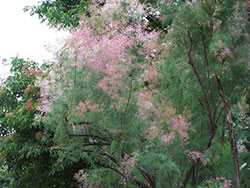
Tamarisk or saltcedar was introduced as an ornamental and for erosion control but it has become the number one threat to riparian ecosystem health in the southwestern United States. Over one million acres of riparian habitats are estimated to be dominated by this species. It is now the third most common woody plant in Western riparian areas.
Tamarisk spreads by seeds (600,000 wind-dispersed seeds per year per plant) and through adventitious roots from the parent plant. Individual roots and stems can set root in new areas which allows it to spread quickly. It also secretes salt through its leaves making the soil too salty for native plants.
A dense, one acre stand can use over 9 acre-feet of water per year, and a single plant can transpire 200 gallons a day – the same amount of water that a small family might otherwise use. This reduces river flows and causes problems with water rights and water delivery obligations.
The most successful method for managing saltcedar involves integrating root plowing and burning of the debris with repeated herbicide treatments on the new growth. Contact a licensed pesticide applicator or vegetation control specialist. Biocontrol insects, including the Tamarisk leaf beetle, have been successful, and are an often overlooked step in reclaiming riparian habitat. Additionally, replanting native stream bank species can help the fight against tamarisk.
For more information, see the following Colorado State University Extension fact sheet(s).
For more information, see the following Planttalk Colorado™ script(s).



